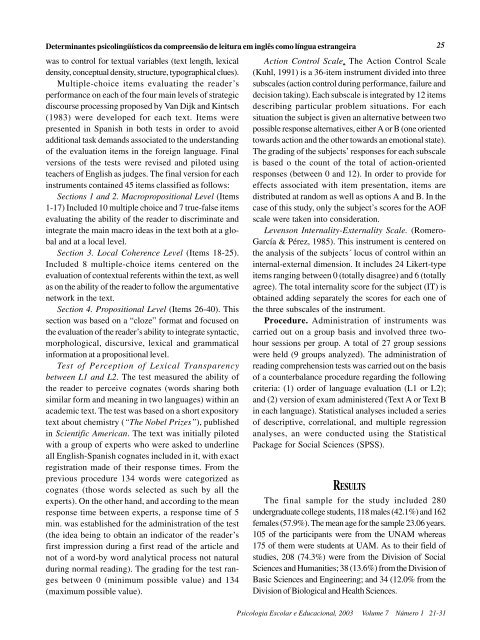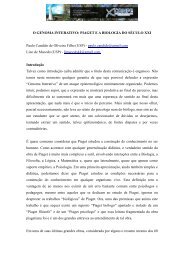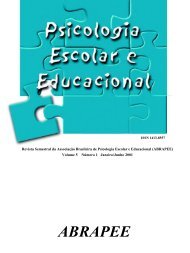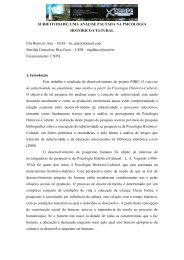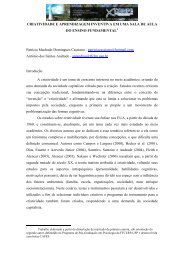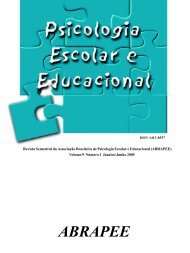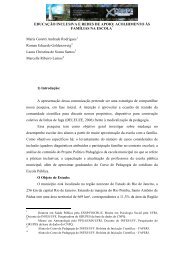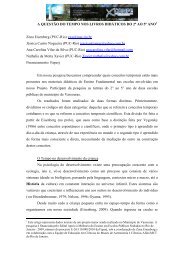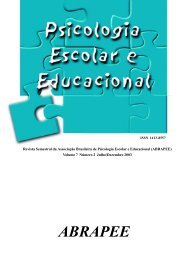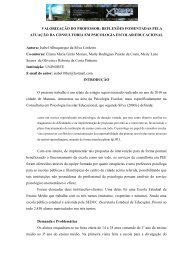24Javier Vivaldo-Lima M.A., Miguel López-Olivas PhD. e Rosa Obdulia González-Robles M.Sc.Action Control. The construct of action control,advanced by Kuhl (1987), refers to a meta-cognitiveprocess that mediates the execution of an action relatedto an intention of an individual. The process organizesand controls cognitive operations, such as <strong>se</strong>lectiveattention and the am<strong>ou</strong>nt and quality of informationproces<strong>se</strong>d in a way that maximizes the congruencebetween intention and performance. The extent of actioncontrol evoked in a particular situation varies along thetwo ends of a continuum between action and stateorientation. State-oriented cognitions do not evoke anytendency to action but can actively inhibit the expressionof action tendencies as a result of a partial incompatibilitybetween action and state orientation. That is, accordingto Kuhl (1987), in a complex problem-solving situation,as the am<strong>ou</strong>nt of state-oriented cognitions increa<strong>se</strong>s,the likelihood that the individual performs an expectedaction tends to decrea<strong>se</strong>. It is assumed that an actionthat demands complex preparatory planning cannot becarried <strong>ou</strong>t when the organism is state-oriented sincepart of the attentional capacity required is employed instate-oriented proces<strong>se</strong>s. Re<strong>se</strong>arch studies focu<strong>se</strong>d onthe analysis of the relationship between action controland reading comprehension are not reported in theliterature. Nevertheless, ba<strong>se</strong>d on a conceptualizationof the reading process in L2 as a complex problemsolvingendeavor, and on the results of preliminaryexploratory studies conducted with Mexican universitystudents, it was considered that the reader’s actioncontrol orientation may also contribute to explain thevariability in L2.Re<strong>se</strong>arch hypothesisAs can be concluded from the previ<strong>ou</strong>s revision ofliterature, the individual influence on readingcomprehension of the linguistic and psychologicalvariables incorporated into the model has beendocumented on the re<strong>se</strong>arch literature. However, noprevi<strong>ou</strong>s attempts to integrate the two dimensions into asingle, comprehensive model of reading have beenreported. Therefore, the purpo<strong>se</strong> of this study was toexamine the explanatory power of a multivariate modelof reading centered ar<strong>ou</strong>nd two dimensions of analysis:the linguistic and the psychological. The model wastranslated into the following re<strong>se</strong>arch hypothesisReading comprehension in English in Mexicanuniversity students, native speakers of Spanish, is afunction of their level of reading comprehension inSpanish (reading strategies in L1); of their level oflinguistic competence in the foreign language; of theirability to perceive lexical transparency between boththe first and the foreign language; of their cognitive style(field dependence vs. field independence); of their locusof control (internal vs. external); and of the type of actioncontrol orientation.METHODParticipants. Two hundred and eighty voluntaryundergraduate college students from two Mexican publicuniversities participated in the study, 118 males and 162females. As to the institution of reference, 105 werefrom the Universidad Nacional Autónoma de México(UNAM) and 175 from the Universidad AutónomaMetropolitana (UAM).Instruments. The evaluation of the sample wasba<strong>se</strong>d on the administration of a battery of testsintegrated by the following instruments: (1) Test ofDisc<strong>ou</strong>r<strong>se</strong> Processing in English as a Foreign Language(Vivaldo, 1994); (2) Test of Disc<strong>ou</strong>r<strong>se</strong> Processing inSpanish as a First Language (Vivaldo, 1994); (3) NelsonEnglish Language Test-Level 150 (Fowler & Coe,1976); (4) Test of Perception of Lexical Transparencybetween English and Spanish (Vivaldo, 1992); (5) TheEmbedded Figures Test (Witkin, Oltman, Raskin & Karp,1971); (6) Internality-Externality Scale (Romero-García& Pérez, 1983); and (7) Action Control Scale (Kuhl,1990). Following a brief description of each instrumentis pre<strong>se</strong>nted.Tests of Disc<strong>ou</strong>r<strong>se</strong> Processing Strategies inEnglish and Spanish. Two equivalent tests for theevaluation of reading comprehension in English andSpanish were developed specifically for the study. Thetheoretical and methodological approach to theevaluation of reading comprehension was ba<strong>se</strong>d on anextrapolation of the strategic model of disc<strong>ou</strong>r<strong>se</strong>processing developed by Van Dijk and Kintsch (1983).The evaluation involved the analysis of the reader’sperformance at the following major levels of disc<strong>ou</strong>r<strong>se</strong>processing: schematic, macro propositional, localcoherence and propositional.Given that a major methodological challenge of thestudy was to assure the equivalence between theevaluation of reading strategies in English and in Spanish,a major consideration in the design of the<strong>se</strong> instruments
Determinantes psicolingüísticos da compreensão de leitura em inglês como língua estrangeira 25was to control for textual variables (text length, lexicaldensity, conceptual density, structure, typographical clues).Multiple-choice items evaluating the reader’sperformance on each of the f<strong>ou</strong>r main levels of strategicdisc<strong>ou</strong>r<strong>se</strong> processing propo<strong>se</strong>d by Van Dijk and Kintsch(1983) were developed for each text. Items werepre<strong>se</strong>nted in Spanish in both tests in order to avoidadditional task demands associated to the understandingof the evaluation items in the foreign language. Finalversions of the tests were revi<strong>se</strong>d and piloted usingteachers of English as judges. The final version for eachinstruments contained 45 items classified as follows:Sections 1 and 2. Macropropositional Level (Items1-17) Included 10 multiple choice and 7 true-fal<strong>se</strong> item<strong>se</strong>valuating the ability of the reader to discriminate andintegrate the main macro ideas in the text both at a globaland at a local level.Section 3. Local Coherence Level (Items 18-25).Included 8 multiple-choice items centered on theevaluation of contextual referents within the text, as wellas on the ability of the reader to follow the argumentativenetwork in the text.Section 4. Propositional Level (Items 26-40). This<strong>se</strong>ction was ba<strong>se</strong>d on a “cloze” format and focu<strong>se</strong>d onthe evaluation of the reader’s ability to integrate syntactic,morphological, discursive, lexical and grammaticalinformation at a propositional level.Test of Perception of Lexical Transparencybetween L1 and L2. The test measured the ability ofthe reader to perceive cognates (words sharing bothsimilar form and meaning in two languages) within anacademic text. The test was ba<strong>se</strong>d on a short expositorytext ab<strong>ou</strong>t chemistry (“The Nobel Prizes”), publishedin Scientific American. The text was initially pilotedwith a gr<strong>ou</strong>p of experts who were asked to underlineall English-Spanish cognates included in it, with exactregistration made of their respon<strong>se</strong> times. From theprevi<strong>ou</strong>s procedure 134 words were categorized ascognates (tho<strong>se</strong> words <strong>se</strong>lected as such by all theexperts). On the other hand, and according to the meanrespon<strong>se</strong> time between experts, a respon<strong>se</strong> time of 5min. was established for the administration of the test(the idea being to obtain an indicator of the reader’sfirst impression during a first read of the article andnot of a word-by word analytical process not naturalduring normal reading). The grading for the test rangesbetween 0 (minimum possible value) and 134(maximum possible value).Action Control Scale. The Action Control Scale(Kuhl, 1991) is a 36-item instrument divided into threesubscales (action control during performance, failure anddecision taking). Each subscale is integrated by 12 itemsdescribing particular problem situations. For eachsituation the subject is given an alternative between twopossible respon<strong>se</strong> alternatives, either A or B (one orientedtowards action and the other towards an emotional state).The grading of the subjects’ respon<strong>se</strong>s for each subscaleis ba<strong>se</strong>d o the c<strong>ou</strong>nt of the total of action-orientedrespon<strong>se</strong>s (between 0 and 12). In order to provide foreffects associated with item pre<strong>se</strong>ntation, items aredistributed at random as well as options A and B. In theca<strong>se</strong> of this study, only the subject’s scores for the AOFscale were taken into consideration.Levenson Internality-Externality Scale. (Romero-García & Pérez, 1985). This instrument is centered onthe analysis of the subjects´ locus of control within aninternal-external dimension. It includes 24 Likert-typeitems ranging between 0 (totally disagree) and 6 (totallyagree). The total internality score for the subject (IT) isobtained adding <strong>se</strong>parately the scores for each one ofthe three subscales of the instrument.Procedure. Administration of instruments wascarried <strong>ou</strong>t on a gr<strong>ou</strong>p basis and involved three twoh<strong>ou</strong>r<strong>se</strong>ssions per gr<strong>ou</strong>p. A total of 27 gr<strong>ou</strong>p <strong>se</strong>ssionswere held (9 gr<strong>ou</strong>ps analyzed). The administration ofreading comprehension tests was carried <strong>ou</strong>t on the basisof a c<strong>ou</strong>nterbalance procedure regarding the followingcriteria: (1) order of language evaluation (L1 or L2);and (2) version of exam administered (Text A or Text Bin each language). Statistical analy<strong>se</strong>s included a <strong>se</strong>riesof descriptive, correlational, and multiple regressionanaly<strong>se</strong>s, an were conducted using the StatisticalPackage for Social Sciences (SPSS).RESULTSThe final sample for the study included 280undergraduate college students, 118 males (42.1%) and 162females (57.9%). The mean age for the sample 23.06 years.105 of the participants were from the UNAM whereas175 of them were students at UAM. As to their field ofstudies, 208 (74.3%) were from the Division of SocialSciences and Humanities; 38 (13.6%) from the Division ofBasic Sciences and Engineering; and 34 (12.0% from theDivision of Biological and Health Sciences.<strong>Psic</strong>ologia Escolar e Educacional, 2003 Volume 7 Número 1 21-31
- Page 1 and 2: ISSN 1413-8557Revista Semestral da
- Page 3 and 4: Psicologia Escolare EducacionalISSN
- Page 5 and 6: SUMMARYISSN 1413-85577 EditorialPap
- Page 7 and 8: EDITORIALAs perspectivas da psicolo
- Page 9: Artigos
- Page 12 and 13: 12iniciando pela teoria do Ensino p
- Page 14 and 15: 14Clara Vasconcelos, João Félix P
- Page 16 and 17: 16refletem a idéia de que a aprend
- Page 18 and 19: 18REFERÊNCIASAlmeida, L. S. (1996)
- Page 21 and 22: Psicologia Escolar e Educacional, 2
- Page 23: Determinantes psicolingüísticos d
- Page 27 and 28: Determinantes psicolingüísticos d
- Page 29 and 30: Determinantes psicolingüísticos d
- Page 31: Determinantes psicolingüísticos d
- Page 34 and 35: 34 Geraldina Porto Wittercolonial.
- Page 36 and 37: 36 Geraldina Porto WitterComo lembr
- Page 38 and 39: 38 Geraldina Porto Witterde remedia
- Page 40 and 41: são é pelo menos apressada, em ce
- Page 42 and 43: 42 Geraldina Porto Witter13.808 pro
- Page 44 and 45: 44 Geraldina Porto WitterÉ uma pro
- Page 46 and 47: 46 Geraldina Porto WitterSaigh, P.
- Page 48 and 49: 48 Ana Paula Porto Noronha, Flávia
- Page 50 and 51: 50 Ana Paula Porto Noronha, Flávia
- Page 52 and 53: 52 Ana Paula Porto Noronha, Flávia
- Page 54 and 55: 54 Ana Paula Porto Noronha, Flávia
- Page 56 and 57: 56 Ana Paula Porto Noronha, Flávia
- Page 58 and 59: 58 Neusa Haruka Sezaki Grittide lí
- Page 60 and 61: 60 Neusa Haruka Sezaki GrittiT 2e T
- Page 62 and 63: 62 Neusa Haruka Sezaki GrittiO tota
- Page 64 and 65: 64 Neusa Haruka Sezaki Gritticonsid
- Page 66 and 67: 66 Neusa Haruka Sezaki Grittite, co
- Page 68 and 69: 68 Neusa Haruka Sezaki GrittiREFER
- Page 70 and 71: 70 Lílian Pacheco e Fermino Fernan
- Page 72 and 73: 72 Lílian Pacheco e Fermino Fernan
- Page 74 and 75:
74 Lílian Pacheco e Fermino Fernan
- Page 76 and 77:
76 Lílian Pacheco e Fermino Fernan
- Page 78 and 79:
78 Miriam Cruvinel e Evely Boruchov
- Page 80 and 81:
80 Miriam Cruvinel e Evely Boruchov
- Page 82 and 83:
82 Miriam Cruvinel e Evely Boruchov
- Page 84 and 85:
84 Miriam Cruvinel e Evely Boruchov
- Page 86 and 87:
86 Patrícia Fernanda Carmem Kebach
- Page 88 and 89:
88 Patrícia Fernanda Carmem Kebach
- Page 90 and 91:
90 Patrícia Fernanda Carmem Kebach
- Page 92 and 93:
92 Patrícia Fernanda Carmem Kebach
- Page 94 and 95:
94 Patrícia Fernanda Carmem Kebach
- Page 96 and 97:
96 Patrícia Fernanda Carmem Kebach
- Page 98 and 99:
98primeira parte, a autora apresent
- Page 100 and 101:
100 HistóriaPsicologia Escolar, ex
- Page 103 and 104:
Sugestões PráticasSEXUALIDADE E E
- Page 105 and 106:
InformativoNOTÍCIAS BIBLIOGRÁFICA
- Page 107 and 108:
Informativo 107I CONGRESSO NACIONAL
- Page 109 and 110:
Informativo 1091.2. Sugestão de t
- Page 111 and 112:
Informativo 111Tipos Comuns de Cita
- Page 113 and 114:
Informativo 113No texto, citar o an
- Page 115:
FORMULÁRIO PARA PAGAMENTO DA ANUID


